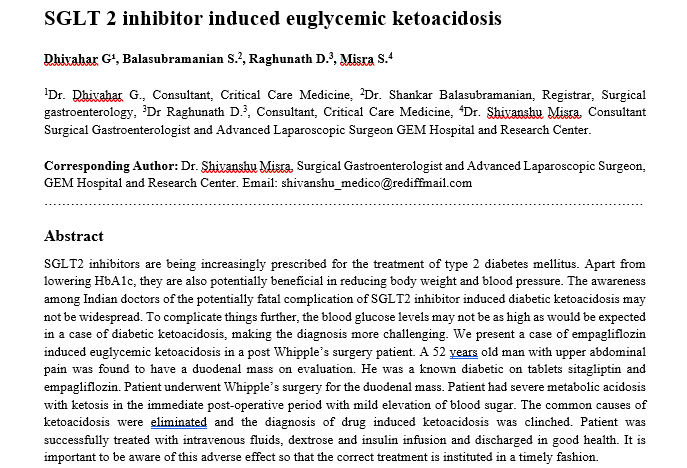SGLT 2 inhibitor induced euglycemic ketoacidosis
Abstract
SGLT2 inhibitors are being increasingly prescribed for the treatment of type 2 diabetes mellitus. Apart from lowering HbA1c, they are also potentially beneficial in reducing body weight and blood pressure. The awareness among Indian doctors of the potentially fatal complication of SGLT2 inhibitor induced diabetic ketoacidosis may not be widespread. To complicate things further, the blood glucose levels may not be as high as would be expected in a case of diabetic ketoacidosis, making the diagnosis more challenging. We present a case of empagliflozin induced euglycemic ketoacidosis in a post Whipple’s surgery patient. A 52 years old man with upper abdominal pain was found to have a duodenal mass on evaluation. He was a known diabetic on tablets sitagliptin and empagliflozin. Patient underwent Whipple’s surgery for the duodenal mass. Patient had severe metabolic acidosis with ketosis in the immediate post-operative period with mild elevation of blood sugar. The common causes of ketoacidosis were eliminated and the diagnosis of drug induced ketoacidosis was clinched. Patient was successfully treated with intravenous fluids, dextrose and insulin infusion and discharged in good health. It is important to be aware of this adverse effect so that the correct treatment is instituted in a timely fashion.
Downloads
References
Bonora BM, Avogaro A, Fadini GP. Sodium-glucose co-transporter-2 inhibitors and diabetic ketoacidosis: An updated review of the literature. Diabetes Obes Metab. 2018;20(1):25-33. doi: https://doi.org/10.1111/dom.13012.
Zinman B, Wanner C, Lachin JM, Fitchett D, Bluhmki E, Hantel S et al. Empagliflozin, cardiovascular outcomes, and mortality in type 2 diabetes. N Engl J Med. 2015;373:2117-2128. doi: https://doi.org/10.1056/NEJMoa1504720.
Turner J, Begum T, Smalligan RD. Canagliflozin-induced diabetic ketoacidosis. J Investig Med High Impact Case Rep. 2016;4(3):2324709616663231. doi: https://doi.org/10.1177/2324709616663231.
Kalra S. Sodium glucose co-transporter 2 inhibitors: a review of their basic and clinical pharmacology. Diabetes Ther. 2014;5(2):355-366. doi: https://doi.org/10.1007/s13300-014-0089-4.
Nauck MA. Update on developments with SGLT2 inhibitors in the management of type 2 diabetes. Drug Des Devel Ther. 2014;8:1335-1380. doi: https://dx.doi.org/10.2147%2FDDDT.S50773.
U.S. Food and Drug Administration. Drug Safety Communication: FDA revises labels ofSGLT2 inhibitors for diabetes to include warnings about too much acid in the blood and serious urinary tract infections.2015. Available at: https://www.fda.gov/Drugs/DrugSafety/ucm475463.htm.
Candelario N, Wykretowicz J. The DKA that wasn’t: a case of euglycemic diabetic ketoacidosis due to empagliflozin. Oxf Med Case Reports. 2016;7:144-146. doi: https://dx.doi.org/10.1093%2Fomcr%2Fomw061.
Pfutzner A, Klonoff D, Heinemann L, Ejskjaer N, Pickup J. Euglycemic ketosis in patients with type 2 diabetes on SGLT2-inhibitor therapy- an emerging problem and solutions offered by diabetes technology. Endocrine. 2017;56(1):212-216. doi: https://doi.org/10.1007/s12020-017-1264-y.
Duggan EW, Carlson K, Umpierrez GE. Perioperative hyperglycemia management: an update. Anesthesiol. 2017;126(3):547-560. https://doi.org/10.1097/ALN.0000000000001515.
Rosenstock J, Ferrannini E. Euglycemic diabetic ketoacidosis: a predictable, detectable, and preventable safety concern with SGLT2 inhibitors. Diabetes Care. 2015;38(9):1638-1642. doi: https://doi.org/10.2337/dc15-1380.

Copyright (c) 2020 Author (s). Published by Siddharth Health Research and Social Welfare Society

This work is licensed under a Creative Commons Attribution 4.0 International License.


 OAI - Open Archives Initiative
OAI - Open Archives Initiative


















 Therapoid
Therapoid

